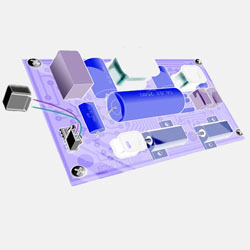
Why 4-Way ?
(1) Harmonics: For high frequency, most tweeters can be crossed over at 3 kHz, but can easily be destroyed at high power. The lower a tweeter is crossed over the less power they can handle. Below 6kHz the power rating of most dome, ribbon and bullet tweeters, reduces at -6 dB/octave (1/4 power for each octave decrease).
Eg. A tweeter rated at 40 watts will only be capable of 10 watts at 3 kHz. Tweeters should be crossed over at approximately 4 kHz—6 kHz for maximum dynamic power response. A compression bullet tweeter is approximately 12 dB—20 dB more efficient than a dome tweeter.
(2) Upper voice: A 4- to 5-inch loudspeaker may just reach 6 kHz linearly but below 400 Hz, efficiency reduces at approximately -6 dB/octave. Compression drivers for professional sound systems are capable of reaching 6 kHz, but are rarely capable of going below 800 Hz. A compression driver may be capable of 50 to 100 watts above 1 kHz, but below 800 Hz a few watts can easily destroy them. A compression driver and horn is approximately 12 dB—24 dB more efficient than a cone loudspeaker.
(3) Lower voice: approximately 100 Hz—400/800 Hz is in between the bass and upper voice. A heavy cone loudspeaker designed for bass may be able to cover this frequency range, but it will not have the efficiency to match the upper voice loudspeaker.
An 8- to 12-inch MB (mid-bass) is similar to a bass loudspeaker but will have a low weight cone with a short voice coil. It will be approximately 3 dB more efficient than a bass speaker, but it will still be less efficient than the upper voice speaker (-3 dB approximately). For professional applications, MB lower voice speaker should be at least x 2 power rating of the upper voice speaker, to maintain equal spectral balance.
(4) Bass: At high power, the large physical movement (excursion) of the louspeaker cone will intermodulate and distort the lower voice. A separate bass (sub-bass) should be added to cover the bass notes and be crossed at the lower end of the voice range approximately 100 Hz. This makes the system a 4-way.
Because the bass (sub-bass) speaker is less efficient, two bass loudspeakers are required for correct spectral power balance to equal the MB lower voice loudspeaker. For professional sound systems, Two bass (sub-bass) loudspeakers for one lower voice loudspeaker is essential.
The best way to understand a 4-way loudspeaker system is to approach it a 3-way with an added active bass (sub-bass). The words bass and sub-bass are ambiguous and often include each other. The lowest bass note on a bass guitar and double bass is open E 42Hz. The musical bass register refers to the lowest 1.5 octaves on the bass instrument 42Hz – 120Hz.
Note: Below open E 42Hz (lowest bass note on a double-bass) the efficiency of most bass loudspeakers, decreases at -12 dB/octave.
At 20 Hz, a bass loudspeaker may require x 16 power to bring it to the same level at 40 Hz. Our ears are -20 dB (1/100) less sensitive to hearing sound at 20 Hz compared to 42 Hz. There are a few audiophile sub-bass loudspeaker systems that go down to 20 Hz and are crossed over at approximately 60 Hz, but professional bass musicians find these audiophile sub-bass systems unusable (un-musical) as a bass loudspeaker system in a band or orchestra.
Efficiency
• Efficiency is measured on axis, 1 watt at 1 meter.
• Cone speakers vary between 86 – 96 dB/mW.
• Compression drivers and horns, and bullet tweeters, approximately 110 dB/mW.
General Rule:
An 8- to 12-inch lower voice loudspeaker (short voice coil – hi resonant – low mass cone) is approximately +3 dB to +6 dB more efficient than a large 12- to 18-inch bass loudspeaker (long voice coil—low resonant—heavy thick cone).
A 4- to 5-inch upper voice loudspeaker is approximately +3 dB more efficient than the 8- to 12-inch lower voice loudspeaker. A dome tweeter is approximately +3 dB more efficient than the 4- to 5-inch upper voice loudspeaker.
For professional sound systems a compression driver horn and bullet tweeter are approximately +12 dB to +20 dB more efficient than cone loudspeakers. The efficiency difference between loudspeakers, using passive crossovers is managed by attenuators called L-pads (similar to a large volume control at the loudspeaker).For active loudspeaker systems, the efficiency difference between loudspeakers is managed by adjusting the level controls of the amplifiers.


